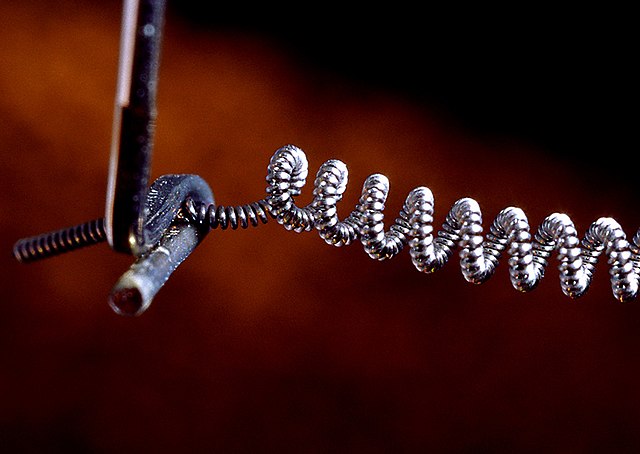
Image 1 Caption: The compounded helix structure (called a coiled coil) of the tungsten (symbol W, Z=74) filament of a 200-watt incandescent light bulb.
Features:
- The total length of
a filament
is of order 0.5--1 meters
and its diameter
is typically of order 0.050 mm = 500 microns (μm).
The image scale is about 10 mm it seems.
- The melting point of
tungsten is
3695 K = 3422°C (at about
STP)
which is the highest of all pure
metals.
The high melting point
is why tungsten can be used
for filaments
which typically work in the
temperature range 2000--3300 K
(see Wikipedia:
Incandescent light bulb: Construction).
- Filaments
look
white hot
due to the
psychophysical response
of human eye
photopic vision
(i.e., human eye vision under well lit conditions)
(see Temperature of a "White Hot"Object,
Carine Fang, 2001;
Wikipedia: Thermal radiation:
Subjective color to the eye of a black body thermal radiator;
Wikipedia: Red heat).
However, for their working
temperature range 2000--3300 K
(see Wikipedia:
Incandescent light bulb: Construction),
they have
a blackbody spectrum peak
in the range ∼ 0.88--1.45 μm which is in the
infrared 0.7 μm -- 0.1 cm
(see Wikipedia: Wien's law).
- Actually, incandescent light bulbs
are NOT very efficient.
Only ∼ < 5 % of the
output energy comes out as
visible band (fiducial range 0.4--0.7 μm
= 4000--7000 Å)
(see Wikipedia:
Incandescent light bulb: Efficacy, efficiency).
The low electrical efficiency
is illustrated by Image 2 where one can see
that most of the energy
of the blackbody spectrum
is in the infrared 0.7 μm -- 0.1 cm.

- Image 2 Caption: The short wavelength part of the near blackbody spectrum of a 25-watt incandescent light bulb. Shown are the ultraviolet band (fiducial range 0.01--0.4 μm) (very low), visible band (fiducial range 0.4--0.7 μm = 4000--7000 Å), and part of the infrared band (fiducial range 0.7 μm -- 0.1 cm). The temperature of the filament may be ∼ 2000 K (see Wikipedia: Incandescent light bulb: Construction).
- To explicate the low electrical efficiency of the incandescent light bulbs, note that the filament radiates to good approximation like a blackbody radiator, and so obeys to good approximation Wien's law and the Stefan-Boltzmann law. Because of Wien's law, the filament has to be at ∼ 2000--3300 K (see Wikipedia: Incandescent light bulb: Construction) to radiate significantly in the visible band and that's low enough NOT to melt the tungsten, but so low that only ∼ < 5 % of the output energy is in the visible band (fiducial range 0.4--0.7 μm = 4000--7000 Å) (see Wikipedia: Incandescent light bulb: Efficacy, efficiency).
Most of the output energy comes out in the infrared band (fiducial range 0.7 μm -- 0.1 cm) and dissipates into heat energy in the surroundings (i.e., into waste heat).
- Because of low electrical efficiency, incandescent light bulbs might be phased out in the near future in favor of fluorescent lamps and light-emitting diodes (LEDs).
- Why is the coiled coil filament is used? It gives a larger radiating surface area per volume than any other practical radiating filament allowing the filament to output a high radiant flux (AKA radiant power) without having the filament temperature exceed the melting point of tungsten. One has give an explication with to show that this is so.
Explication:
- In general, radiating strength for an object increases at least roughly as its
surface-area-to-volume ratio
increases all other things being equal, particularly with volume equal.
- The smallest
surface-area-to-volume ratio
is for a sphere
(more exactly a solid sphere (AKA ball))
which you might have guessed since a
sphere seems maximally compact
(see Wikipedia:
Surface-area-to-volume ratio).
So a sphere seems
a good standard of comparison for the
surface-area-to-volume ratio
of any other object of the same
volume.
- The
surface-area-to-volume ratio
of a long
cylinder
(so long that its end areas are negligible)
in ratio to
surface-area-to-volume ratio
a sphere of the same
volume as the
cylinder and depending
only on cylinder
parameters can be called
the R formula:
R = [(2/9)**(1/3)]*(L/a)**(1/3) = (0.6057 ...)(L/a)**(1/3) .
- From the R formula, you see you can make the ratio R arbitrarily large by increasing L/a while keeping volume fixed (and therefore the amount of tungsten used fixed in a filament). In practice, there are limitations on the how large L/a can be.
- Now both a cylinder and a sphere of tungsten will have the same output radiant flux (AKA radiant power) for input electrical power (wattage) by conservation of energy ideally in theory. But to make up for its relatively low radiating surface area, the sphere will radiate at a much higher temperature than the cylinder. So you would have to keep the temperature of the sphere much lower than you would for the cylinder, and so keep its output radiant flux (AKA radiant power) lower and the amount of radiant flux (AKA radiant power) in the visible band (fiducial range 0.4--0.7 μm = 4000--7000 Å) probably very low.
- Note cylinder filament is wrapped into coiled coil filament to make the cylinder filament compact, but NOT as compact as a sphere of the same volume.
- The proof of the R formula is given in Electromagnetic Radiation file: light_incandescent_filament_4.html or below if this is actually that file.
- Image 2 Caption: The short wavelength part of the near blackbody spectrum of a 25-watt incandescent light bulb. Shown are the ultraviolet band (fiducial range 0.01--0.4 μm) (very low), visible band (fiducial range 0.4--0.7 μm = 4000--7000 Å), and part of the infrared band (fiducial range 0.7 μm -- 0.1 cm). The temperature of the filament may be ∼ 2000 K (see Wikipedia: Incandescent light bulb: Construction).
-
Images:
- Credit/Permission: User:Lander777,
2007 /
Public domain.
Image link: Wikipedia: File:Filament.jpg.
-
Credit/Permission: ©
User:Thorseth,
2015 /
CC BY-SA 4.0.
Image link: Wikimedia Commons: File:Spectral power distribution of a 25 W incandescent light bulb.png.
Extended file: Electromagnetic Radiation file: light_incandescent_filament_4.html.
File: Electromagnetic Radiation file: light_incandescent_filament.html.